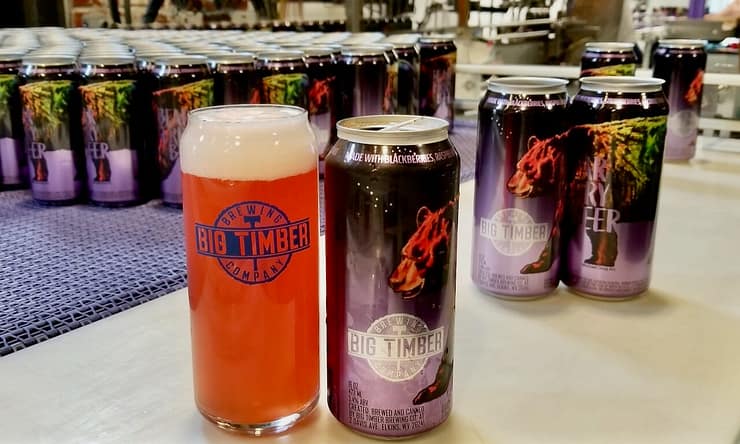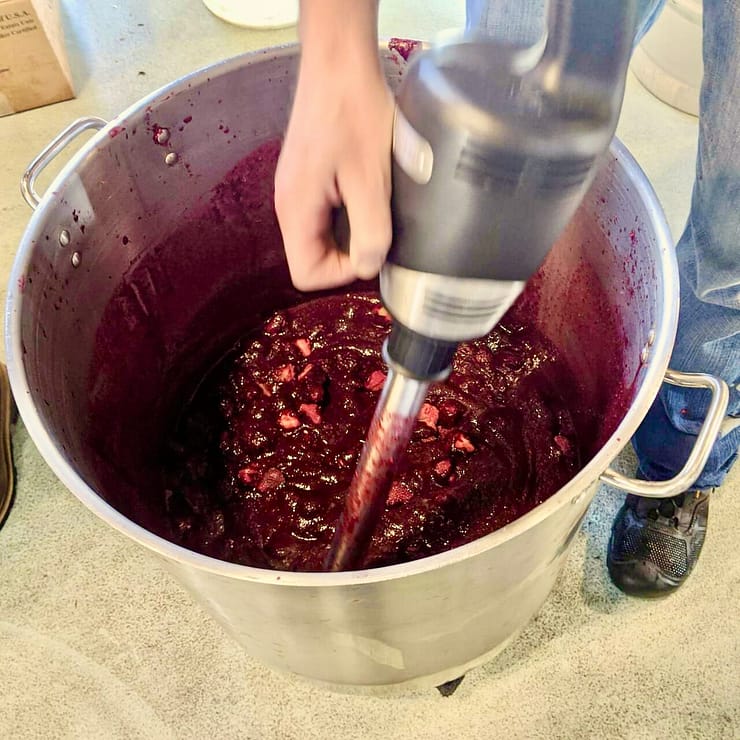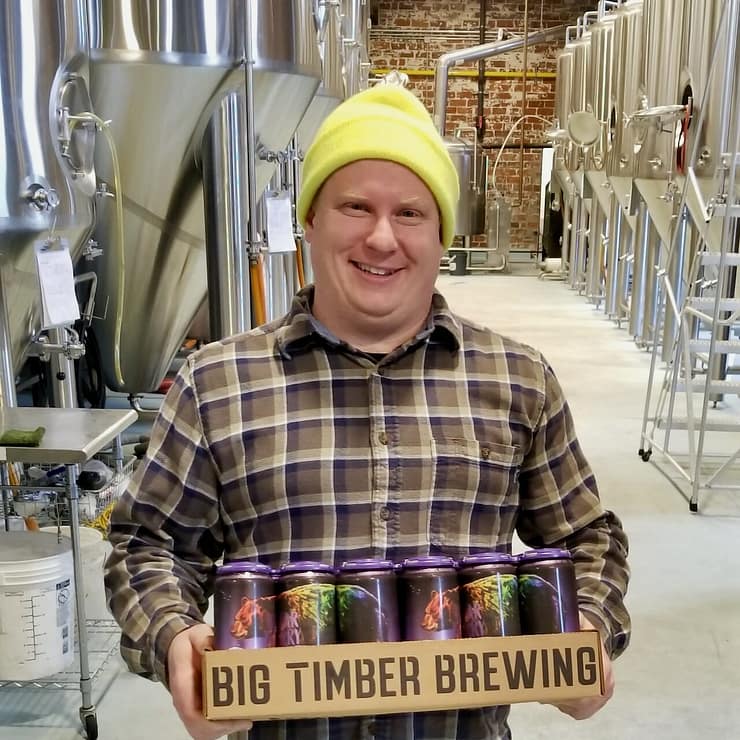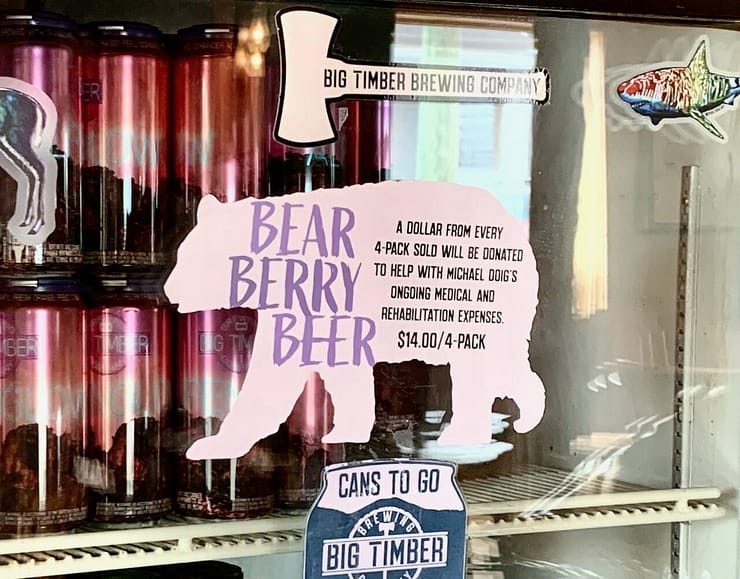
Anatomy of a Fruited Gose – Bear Berry
February 6, 2020
Once Big Timber Brewing Company got its new, expanded brewery going last year, one thing high in their priorities was producing a series of fruited Gose. Being men and women of their word, the Big Timber crew has now blessed us through the seasons with a group of most lovely Goses, a new one appearing about every other month. Their latest — Bear Berry Beer — may be the best yet.

Prior to moving to their new brewing space, head brewer Matt Kwasniewski had experimented with a small batch of a cranberry-orange fruited Gose they called Alpenglow. The beer received very solid reviews and sold well, even at a considerably higher price point than other Big Timber regular-strength beers. They knew they were onto something.
The Gose style (pronounced GO-zuh) works well with fruit due to its slight salt content that helps brighten the fruit flavors, pushing them to the forefront, while its light acidity balances the sweetness. A Gose knows how to show off its fruit.
Brewing the Gose
The current release of Bear Berry Beer is a perfect example of the Gose art. The grain bill is simple with wheat and pilsner malt. The small amount of hops added produces almost no bitterness or flavor.
In a Gose, the primary flavor creator is the addition of lactobacillus. The lactobacillus strain used is a very similar to the bacteria that makes yogurt out of milk. First, Big Timber mashes the grains (steeps the grain in warm water) to dissolve the sugars producing a sweet liquid called wort. The wort is pumped into the brew kettle, where they do a quick boil on the wort to kill any bacteria and yeast present. Next, they add a dose of lactobacillus to it. The bacteria digests some of the malt sugars in the wort and produces a sour lemony/grapefruit type flavor.
These kind of beers are often called kettle sours because they are soured while the wort is in the brew kettle. After souring, the wort is boiled, killing the lactobacillus bacteria, and the liquid is then transferred to a fermentation tank where it is fermented with brewers yeast.
For a fruited Gose like Bear Berry, relatively large amounts of fruit puree and other flavorings are added to the tank after the primary fermentation is complete. The beer rests on the fruit for a while, picks up the fresh fruit flavors, and ferments little more from the fruit sugars. The finished beer is then carbonated and packaged for sale.
The flavoring ingredients in the 900 gallon (30 barrel) batch of Bear Berry included:
- 450 lbs. of strawberries
- 150 lbs. of blueberries
- 100 lbs. of blackberries
- 100 lbs. of raspberries
- 1.5 lbs. of vanilla beans
- 11.5 lbs of coriander seeds
- 20 lbs of lactose (milk sugar)
- 6 lbs. of salt

The fruit used was frozen whole fruits that the Big Timber brewers manually puréed with a commercial immersion blender. The vanilla beans came from Madagascar and Mexico. The salt was from from J.Q. Dickinson Salt-Works in Malden, WV.
Brewing a fruited Gose like Bear Berry is a complicated, multi-step process and involves a lot of work. The extra expense of the fruit and vanilla drive up the cost of the beer’s ingredients way more than a beer without such flavorings.
The resulting Bear Berry Bear is packed with strawberry and blueberry flavors. The lactose adds a silkiness and a more luscious mouthfeel. The salt comes through a bit at the end like an exclamation point. The tartness and ample carbonation allow the beer to finish clean. The beer checks in at 5.4% ABV. This is one beautifully balanced brew that is fun to drink.
Hitting the market now

Matt says that about 50 cases (16 oz. four-packs) are going out out to distribution along with 60 one-sixth barrel kegs. Expect to find it at craft specialty retailers and bars, wherever Big Timber’s past small batch products have been sold.
“You should see it around the state,” he says. “There’s not a lot of kettle sours out in the state, especially in package, We’re hoping to do a new sour every month and a half of so.”
He says they are learning a lot quickly about making and selling flavored kettle sours like the Gose. They have found some flavors are more popular than others. “I didn’t realize how many people are pretty averse to cucumber,” Matt said about the reaction to the cucumber–dragonfruit Gose they made last summer. “It still did well, but it was definitely a love-hate kind of beer.”
He says their next kettle sour will be the return of Key Lime Pie Gose, which they also made last year. After that, look for a cherry pie flavored one and a piña colada version.
Bear Berry Beer: the inspiration

Bear Berry Beer began as an idea inspired from a painting by Elkins artist Michael Doig. Doig chairs the creative arts programs at Davis and Elkins College and is a fan of Big Timber beer. As part of his personal mission to get more art out in the community, he brought his bear painting by the brewery one day to see if they wanted to display it. The large format painting of a multi-colored bear inspired brewer Matt Kwasniewski. Intuitively, the mix of colors in the painting must have directed his mind toward a mix of colorful berry fruits, which he had previously experimented with. What better beer than a Gose to showcase those fruits and colors.
The bear painting also inspired Matt’s sister, Amber Kwasniewski, who handles label design and social media for the brewery. Since Matt wanted to can the beer, she collaborated with Doig to come up with a concept for the can label design.

“With our small batch/limited release series we’ve kind of taken the liberty to be a little more artistic with our cans,” Amber says.
Their design has to be one of, if not the most beautiful can label West Virginia has ever seen. The label art pulls the original bear on the painting out of its forest background and places it on a field of purple and black. The black portion of the background represents the night sky to which Doig suggested adding a Big Dipper shaped constellation of stars connecting Ursa Major to the painted bear. That’s a nice touch. Translucent inks used on the plastic-wrap label material allow the aluminum can to show through to varying extents. This gives sections of the label a really cool metallic look. Amber used this technique to perfection.
“It was a fun collaboration,” says Amber. “Drinking beer and talking about art. It’s definitely my favorite.”
Bear Berry Beer now a fundraiser too

Shortly after the label design was completed, Doig suffered a serious health incident that left him in the hospital and facing a long-term recovery and rehab. The Big Timber folks immediately knew they wanted to do something to help out.
“A dollar from the sale of every four-pack will go to help fund his medical and rehab expenses,” Matt explains.
Michael Doig and the Big Timber owners are all community-spirited folks that we are lucky to have around our West Virginia beer community. The Brilliant Stream team sends out its thoughts wishing Doig the best during his recovery and rehab process.
Big Timber Brewing Company
2 Davis Ave.
Elkins, WV
Big Timber Brewing Company website
Big Timber is Brilliant Stream’s WV Brewery of the Year

